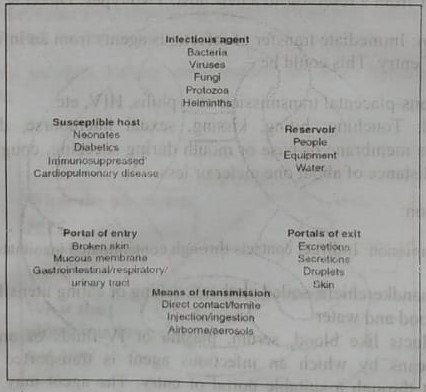Today is our topic of discussion Chain of infection
Chain of infection

Definition:
This refers to a logical sequence of factors or links of a chain that are essential to the development of the infectious agent and propagation of disease. The involved six factors are –
1. Infectious agent (or causative agent)
2. Reservoir
3. Portal of exit
4. Disease transmission (mode of transmission)
5. Portal of entry
6. Susceptible host
Infectious agent:
An organism that is capable of producing infection or infectious disease. On the basis of their size, they are generally classified into-
a. Metazoa (multicellular organisms) – Helminths
b. Protozoa (unicellular organisms) – Amoebae
c. Bacteria (e.g. Treponema pallidum, Mycobacterium tuberculosis, etc)
d. Fungus (e.g. Candida albicans)
e. Virus (e.g. Chickenpox, polio, etc)
Reservoir:
See chapter 14.
Portal of exit:
This is the site through which the agent escapes from the reservoir. Examples are-
a. GIT: Typhoid fever, bacillary dysentery, amoebic dysentery, cholera, ascariasis, etc.)
b. Respiratory: Tuberculosis, common cold, etc.
c. Skin and mucus membranes: Syphilis
Disease transmission:
Refers to the mechanisms by which an infectious agent is transferred from one person to another or from a reservoir to a new host. Two types: Direct & indirect –
Direct transmission:
Immediate transfer of infectious agents from an infected host or reservoir to an appropriate portal of entry. This could be –
a. Direct vertical: Trans-placental transmission of syphilis, HIV, etc.
b. Direct horizontal: Touching, biting, kissing, sexual intercourse, droplet spread onto the conjunctiva or mucus membrane of nose or mouth during sneezing, coughing, spitting or talking: usually limited to a distance of about one meter or less.
Indirect transmission:
Vehicle-borne transmission:
Indirect contacts through contaminated inanimate objects (fomite) like –
a. Bedding, toys, handkerchiefs, soiled clothes, cooking or eating utensils, surgical instruments.
b. Contaminated food and water
c. Biological products like blood, serum, plasma or IV-fluids or any substance serving as intermediate means by which an infectious agent is transported and introduced into a susceptible host through a suitable portal of entry. The agent may or may not multiply or develop in the vehicle before it is introduced into man.

Vector-borne transmission:
Occurs when the infectious agent is conveyed by an arthropod (insect) to a susceptible host-
Mechanical transmission:
The arthropod transports the agent by soiling its feet or body part, in which case multiplication of the agent in the vector does not occur (e.g., common house fly).
Biological transmission:
When the agent multiplies in the arthropod before it is transmitted, such as transmission of malaria by mosquito.
Air-borne transmission:
Dissemination of microbial agent by air to a suitable portal of entry, usually the respiratory tract. Two types of particles are implicated in this kind of spread – Dusts and droplet nuclei.
Portal of entry:
The site through which the infectious agent enters into the susceptible host, Example –
a. Mucus membrane
b. Skin
c. Respiratory tract
d. GIT
e. Blood
Susceptible host (host factors):
A person or animal lacking sufficient resistance to a pathogenic agent to prevent disease when exposed. Resistance to infection is determined by non-specific and specific (genetic) factors. Non-specific factors are-
a. Skin and mucus membrane
b. Mucus, tears, gastric secretion
c. Reflex responses such as coughing and sneezing

Fig: Chain of infection
Incidence:
Incidence is defined as “the number of new cases of a disease occurring in a defined population during a specified period of time”.
Number of new cases of a specific disease in a population during a given time period
Incidence rate = ————————————————————————————————— X 1000
Population at risk during that period
Prevalence:
Prevalence is defined as “the number of all current cases (old and new) of a specified disease existing at a given point in time, or over a period of time in a given population”.
Number of existing cases of a specific disease in the population during a given time period
Prevalence = ——————————————————————————————————- X 1000
Total population during that period
See also :

1 thought on “Chain of infection”